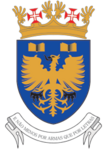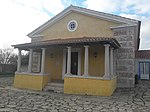Fountain of Armés
Buildings and structures in Lisbon DistrictBuildings and structures in SintraFountains in PortugalProperties of Public Interest in Portugal
The Fountain of Armés (Portuguese: Fonte de Armés), alternatively called the Fountain of the Moors (Portuguese: Fonte dos Mouros), is a 1st-century fountain built by Lucius Iulius Maelo Caudicus, an Olisipo flamen, to honour the Roman Emperor Augustus, in the village of Armés, civil parish of Terrugem in Sintra.
Excerpt from the Wikipedia article Fountain of Armés (License: CC BY-SA 3.0, Authors).Fountain of Armés
Rua casal do vaz,
Geographical coordinates (GPS) Address Nearby Places Show on map
Geographical coordinates (GPS)
| Latitude | Longitude |
|---|---|
| N 38.850161111111 ° | E -9.3430388888889 ° |
Address
Rua casal do vaz
2715-018 (São João das Lampas e Terrugem)
Portugal
Open on Google Maps








